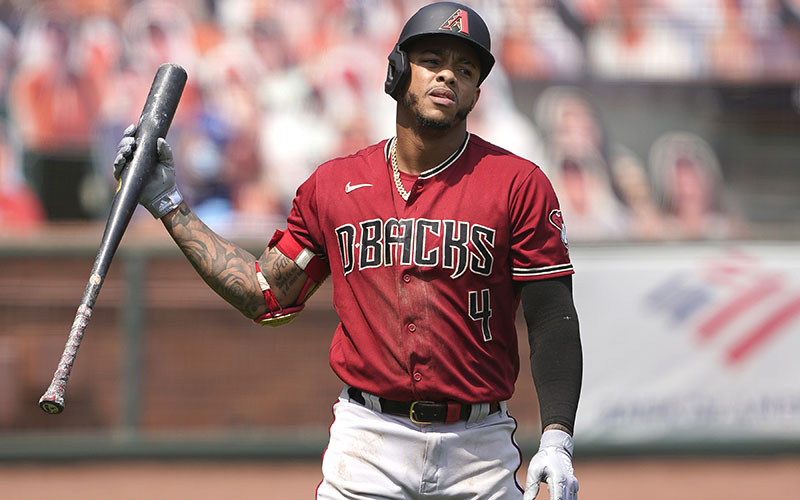Despite a disappointing 2020 season that saw the Diamondbacks finish in last place with a 25-35 record, the organization heads into the offseason confident they can make it back to the playoffs in 2021.
“I don’t really know where the offseason is going to take us, you know, on a very micro-level,” Arizona General Manager Mike Hazen said. “But I never do. I do think this team still, in my mind, has the building blocks of being a good competitive baseball team that is capable of making the playoffs. We’re going to start from that base position.”
Heading into the future, a very important “building block” will be former All-Star Ketel Marte, who had a disappointing 2020 after finishing fourth in 2019 NL MVP voting. After hitting 32 home runs in 2019, Marte only hit two in the 60-game season.
Despite his drop in production and power in particular, Hazen was confident that Marte can return to his 2019 form.
“We think he’s a top-five player (in the league),” Hazen said.
Outside of Marte, Hazen noted that Arizona will be looking for right-handed hitters to anchor the middle of the lineup after the team hit .237 against left-handed pitchers in 2020. Curiously, the D-backs traded outfielder Starling Marte, who was hitting .379 against southpaws, to Miami at the trade deadline.
If the Marte trade is any indication, the Diamondbacks will spend this offseason trying to recoup the production they traded away.
Hazen added that he felt “pretty good about the starting pitching,” despite a team ERA of 4.84. Diamondbacks pitchers also walked the second-most batters in the National League, an area Hazen wants to improve for next year.
“Pitching is the hardest area to assess because pitchers are traditionally ready to ramp up over a course of five-to-six weeks and we gave them, like everybody else, a couple of weeks,” Hazen said. “It’s just harder for us to assess the individual performances.”
Hazen was especially optimistic about left-hander Madison Bumgarner, who missed nearly a month with back issues and posted a 6.48 ERA and 1.44 WHIP, the worst marks of his 11-year career in those categories.
Bumgarner’s ERA ballooned to 9.35 after giving up six runs in two innings to San Diego right before going on the injured list, and he struggled in his first few appearances after coming back.
However, he turned things around by season’s end, pitching 10 scoreless innings and allowing only four hits in his last two starts.
Hazen chose to focus on Bumgarner’s finish rather than his start.
“What we saw at the end was very promising and it’s where we know he’s going to get back to,” Hazen said. “The injury was tough, because it shortened what we were going to get at the end. We signed him and believe in him today just as strong as we did a year ago.”
That “year ago” referred to by Hazen was an exciting time to be a Diamondbacks fan. After making aggressive moves to acquire talent like former All-Stars Bumgarner and Starling Marte, the team looked poised to make a run at a playoff spot.
However, a pandemic and 60 games later, those promising moments feel like a distant memory.
Similar to previous seasons, the Diamondbacks’ campaign was defined by a dismal stretch from Aug. 19 to Sep. 9 in which they only won two of 20 games. Before that stretch, Arizona was 13-11 and firmly in the playoff race.
“We have had this exact conversation about this exact topic seven times or eight times over the four years that we’ve been here because we have hit some lulls that have been frustrating and confusing,” Diamondbacks manager Torey Lovullo said. “You’ll never recover from something like that in a 60-game schedule.”
Hazen agreed that the team has struggled to overcome prolonged losing streaks the past few seasons.
“We go into these periods during the course of the season where we need to start shortening down times of the year that are costing us in the end,” Hazen said. “That has happened in the last couple years… We need to do a better job of getting ourselves out of those ruts and back into more consistent play.”
The Diamondbacks waved the white flag at the trade deadline when they parted ways with several key players, including Marte, who “was probably (their) best player when (they) traded him from a performance standpoint,” according to Hazen.
Those moves at the deadline signaled a transition for Arizona, shifting dependence to younger players and rookies. Those roster changes seemed to be paying off at the end as the club won five of its last six games and 10 of its last 16.
Overall, outside of the 2-18 stretch, the Diamondbacks were 23-17, a mark comparable to some of the better teams in the National League.
“I feel like we have a good baseball team,” Hazen said. “We have a good baseball team that, for whatever reason, as a group, did not come out on the end of making the playoffs.”
Because of the team’s relative success outside of the losing streak, both Hazen and Lovullo felt that their record didn’t reflect the team’s abilities.
“I know one thing is that we started to play good baseball toward the end and that’s sitting on me too right now,” Lovullo said. “I saw some young players come in and do their job and we had a lot of success. At the end of the year, I thought we would have been chasing (other teams) down if we had a longer season.”
Hazen added that he “would probably minimize what we’ve seen to some degree this year,” and that “what we’ve seen is likely abnormal.”
Nonetheless, after missing the playoffs for a third straight season, frustration is still rampant, both among the team’s higher-ups and the players.
“It was a tough year,” Lovullo said. “I’m not going to sugarcoat it. I’m going to wear it for the majority of this offseason.”
“Pissed is probably a good word,” first baseman Christian Walker said. “Not disappointed. That’s not the right word, but definitely feel like we left something on the table. But, you know, it’s not about how you start, it’s how you finish, and (having) perspective here, you know, we played some good baseball at the end.”


